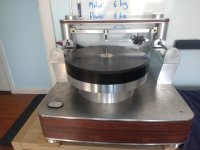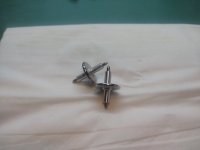Thanks so much for explaining it all, i don't understand yet well enough to see exactly how this is related only and precisely to the lateral stylus movement whilst eliminating any other cause of that same signal, but i will work on it!
M
M
Hello warrjon,
That is a really niece tone arm you have created, congratulations.
Sincerely,
Ralf
That is a really niece tone arm you have created, congratulations.
Sincerely,
Ralf
It lives. Still have to sort out the arm wiring which is temporarily taped to the back of bridge with blue painter tape. First impressions are a big improvement in clarity which I suspect is mostly attributable to the wheels being more concentric than the carbide rings. The carriage now rolls much smoother with no falling to a single position which is good since the wheels alone cost over $600/pair to build. This is still using the old carriage, there is a new CNC version happening and I'll post pic of that when it's done.
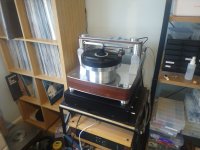

Hi Sether,
How is your experiment with the sapphire wheels coming along, it's been a while since your last update.
I hope they are working well.
How is your experiment with the sapphire wheels coming along, it's been a while since your last update.
I hope they are working well.
Hi Niffy, unfortunately work commitments meant that the project was put on ice since Easter. So frustrating as I was 95% there, I should be able to pick the project up again this winter. I did get slightly sidetracked by designing a material for the plinth and gantry, the brief being excellent damping properties and good machining qualities (and inexpensive !). I hooked up an accelerometer to a UNO to test the damping through LabView. It ended up being a rather interesting sideline. I’ll post pics when I get the chance.
S.
S.
Hi Sether, designing a material sounds intriguing, what did you find? - i like the sound of damping etc.
M
M
Hi Mike, I’ll post some findings soon. Another interesting concept was to add a sapphire veneer to the carriage, stiffening it further ( a smart phone sapphire screen protector). Although I’m unable to find time to complete the project, it’s fun to keep developing it, even if it’s only dreaming!!
S.
S.
Hi Mike,
With a tonearm strength is not of much importance as the loads, both dynamic and static, are very low.
What is important is rigidity. Not only is sapphire extremely hard it is also extremely rigid. Generally the rigidity of a material is closely related to it's hardness.
When bending the greatest stresses are at the surface. Putting very rigid materials on the surface is a good way of increasing carriage rigidity.
With a tonearm strength is not of much importance as the loads, both dynamic and static, are very low.
What is important is rigidity. Not only is sapphire extremely hard it is also extremely rigid. Generally the rigidity of a material is closely related to it's hardness.
When bending the greatest stresses are at the surface. Putting very rigid materials on the surface is a good way of increasing carriage rigidity.
Kuzma make a pivoting tonearm wand from sapphire. @niffy carriage design the first bending mode is at the top of the audio band where there is little energy. I suspect adding sapphire to this carriage might not gain anything except lowing COG. Even with my new wheels which were less than 1/2 the mass of the carbide and 2mm smaller in OD COG was still above the vertical pivot. I have added a 2g washer to the bottom of the carriage as a temporary fix until the new CNC carriage is finished.
@Sether this LTA is so good I have doubts I'll ever build anything else for my own use. This TT/LTA resolve so much detail from the groove I was astounded at the improvement from my previous version. One thing of note is I had to turn the volume up 3dB on the preamp which would indicate that this new setup has reduced resonance in the midrange.
The updates to the LTA over the previous version are, larger bridge with Permalli sandwich, the cross bar that the rail hangs from is stiffer and also has stiffer mount to the height adjustment, blocks, better wheels and a more rigid mount to the plinth. There is an updated cross bar on its way with Permalli inserts to hopefully reduce ringing. Pics of the old and new TT. All the updates have been to increase rigidity.
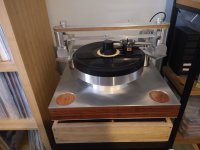
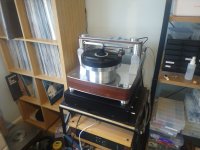
@Sether this LTA is so good I have doubts I'll ever build anything else for my own use. This TT/LTA resolve so much detail from the groove I was astounded at the improvement from my previous version. One thing of note is I had to turn the volume up 3dB on the preamp which would indicate that this new setup has reduced resonance in the midrange.
The updates to the LTA over the previous version are, larger bridge with Permalli sandwich, the cross bar that the rail hangs from is stiffer and also has stiffer mount to the height adjustment, blocks, better wheels and a more rigid mount to the plinth. There is an updated cross bar on its way with Permalli inserts to hopefully reduce ringing. Pics of the old and new TT. All the updates have been to increase rigidity.


I was thinking about bending stiffness of the entity, Niffy, which is what i take to be the rigidity under discussion, and indeed I believe as you state, the greatest stresses will be at the surface and they will be along the plane of the surface wont they? - henvce my feeling that for an attached surface skin its the tensile/compressive strengths of the attached skin that matter rather than rigidity per se, although a rigid material may be suitable in this respect as well?Hi Mike,
With a tonearm strength is not of much importance as the loads, both dynamic and static, are very low.
What is important is rigidity. Not only is sapphire extremely hard it is also extremely rigid. Generally the rigidity of a material is closely related to it's hardness.
When bending the greatest stresses are at the surface. Putting very rigid materials on the surface is a good way of increasing carriage rigidity.
M
Reiterate: strength is not stiffness... Strength is about the forces that break things, not how much they deform for a given load. Brittle materials aren't very strong but can be extremely stiff - for instance glass and aluminium are similar in stiffness, but you wouldn't make a carabiner out of glass!
If we are not talking about material failure, strength is immaterial, as its only about damage/failure.
Having said this, for most ductile metals material damage starts to occur around 0.2% elongation, so strength and stiffness are correlated for these materials. With brittle materials all bets are off - often hardness comes at the expense of strength (harder metal alloys tend to be more brittle).
There's another important property, toughness, which is basically the inverse of brittleness, and often more important in practice than actual strength.
If it wasn't extremely toxic, expensive and brittle, beryllium would be the go-to metal for most applications as its very light, stiff and strong.
If we are not talking about material failure, strength is immaterial, as its only about damage/failure.
Having said this, for most ductile metals material damage starts to occur around 0.2% elongation, so strength and stiffness are correlated for these materials. With brittle materials all bets are off - often hardness comes at the expense of strength (harder metal alloys tend to be more brittle).
There's another important property, toughness, which is basically the inverse of brittleness, and often more important in practice than actual strength.
If it wasn't extremely toxic, expensive and brittle, beryllium would be the go-to metal for most applications as its very light, stiff and strong.
So, now i have the terms correct, does Sapphire glass happen to have a modulus that would make it a good additional coating for the carriage? - as suggested by Sether in #5410?Young's modulus etc are stiffness/rigidity... Yes, given that it makes sense!
@Mike56 I think adding sapphire to @niffy carriage design to increase rigidity it not necessary as the carriage is already extremely rigid due to its construction. IMO there are other areas of the arm that will benefit from improvements like the structure that holds the rail and this is where I have concentrated my efforts to improve the arm.
- Home
- Source & Line
- Analogue Source
- DIY linear tonearm
